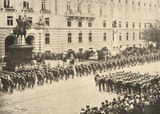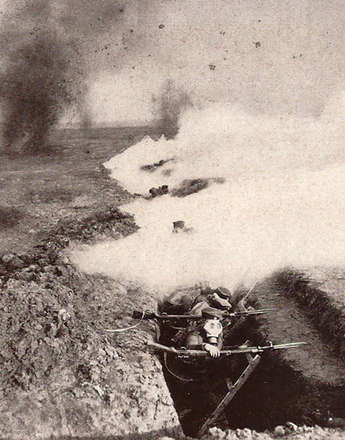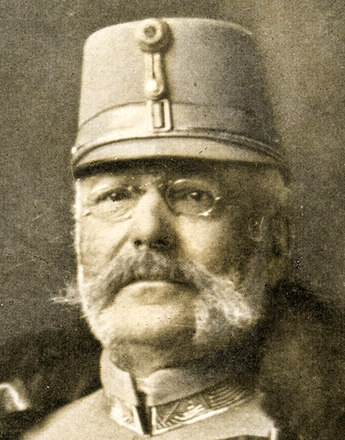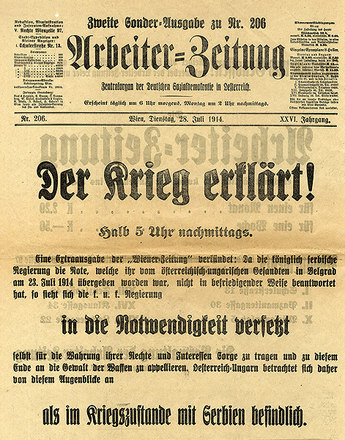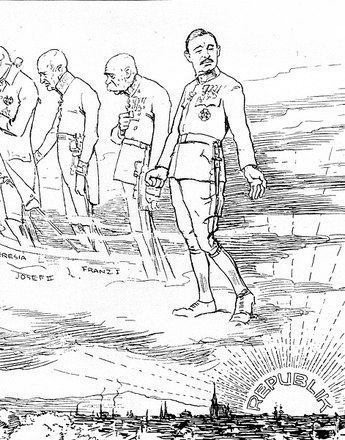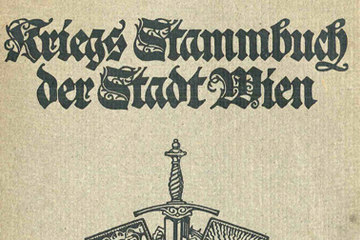Although with a military upbringing like most male Habsburgs, Friedrich was invested with the rank of supreme commander solely thanks to his high birth and not his aptitude. The archduke was an officer for peace time, for parades and manoeuvres, but not for the case of emergency.
At the outbreak of the war Emperor Franz Joseph resigned from the function of Supreme Commander of the Austrian-Hungarian Army for reasons of age and passed it on to Archduke Friedrich (1856–1936) from the Teschen line of the Habsburgs.
The reason was that a member of the archducal house should be represented in the echelons of leadership. The actual successor to the throne, Karl, was seen as too young for the post, thus Friedrich was a convenient resort. He was a grandson of Archduke Karl the victor of Aspern, and a nephew and adoptive son and heir of Archduke Albrecht, the “éminence grise” of the dynasty. Friedrich inherited the enormous possessions of this line of the Habsburgs consisting of far-flung estates and prosperous industrial concerns and also included the Albertina Collection – he was thus one of the richest men in the Monarchy and availed of a greater private fortune than the emperor. But what Friedrich had not inherited from his famous ancestors was their strategic talent. Harmless and of a naïve congeniality, there wasn’t an ounce of ambition in him. This set the stage for the situation in which he would offer no competition for the Chief of General Staff and actual military mastermind Franz Conrad von Hötzendorf. Nicknamed “k. u. k. Großpapa” (it rhymes in German – “ka-und-ka Grosspapa”, imperial and royal Grandpapa), the Archduke was a total yes-man for Conrad and preferred to bask in the outer glory of his honorary post.
Friedrich’s other demeaning nickname “Archduke Bumbsti” goes back to an episode when he was watching a film showing the explosive power of an Austrian 30.5 cm mortar; when the projectile hit the target he commented with a laconic “bumbsti” (oops). Immortalised in literature with this ironic nickname by Karl Kraus in the “Last Days of Mankind”, Friedrich became the symbol of the deficient military capability of the Austrian military command, whose theoretical knowledge fell flat as flat as a wet firework in the reality of war.
His tragic failure and obtuse fussiness in his senile leadership of the Imperial-Royal Army is also revealed in the description of a speech by the Archduke quoted by his adjutant general: although Friedrich had only to read the speech, with pauses and emphases underlined, the speech was a fiasco: The archduke first of all held the text upside down, “and it took a while until he found the first page. (…) Then he started the speech, and, with completely the wrong emphasis, stuttered his way through the first page. Turning the page lasted a while, as did his reading of page two, although the letters were ½ cm in size (…) and so it went on to the end.”
Finally Archduke Friedrich was relieved of his function in February 1917 by Emperor Karl, since the young monarch wished to take over supreme command himself. To disguise the harshly abrupt change-over in generations, Friedrich was sent into retirement with the award of the Maria Theresa Order and all the fittingly flattering titles available in the honours repertoire of Old Austria.
Translation: Abigail Prohaska
Leidinger, Hannes/Moritz, Verena/Schippler, Bernd: Schwarzbuch der Habsburger. Die unrühmliche Geschichte eines Herrscherhauses (2. Auflage, ungekürzte Taschenbuchausgabe), Innsbruck [u.a.] 2010
Rauchensteiner, Manfried: Der Erste Weltkrieg und das Ende der Habsburgermonarchie 1914–1918, Wien u. a. 2013
Quotsation:
“and it took a while ...“, Hauptmann Wille, quoted from: Rauchensteiner, Manfried: Der Erste Weltkrieg und das Ende der Habsburgermonarchie 1914–1918, Wien u. a. 2013, 670
-
Chapters
- Franz Joseph: the ageing emperor
- The problem of the succession
- Franz Joseph and Franz Ferdinand – a tense relationship
- Franz Ferdinand and his political programme
- Kaiser Wilhelm II: The Beloved Enemy
- “Archduke Bumbsti”
- Karl as successor to the throne
- The New Emperor
- Karl I and the collapse of the Monarchy
- The last days of the Monarchy
- Emperor Karl on his way into exile


